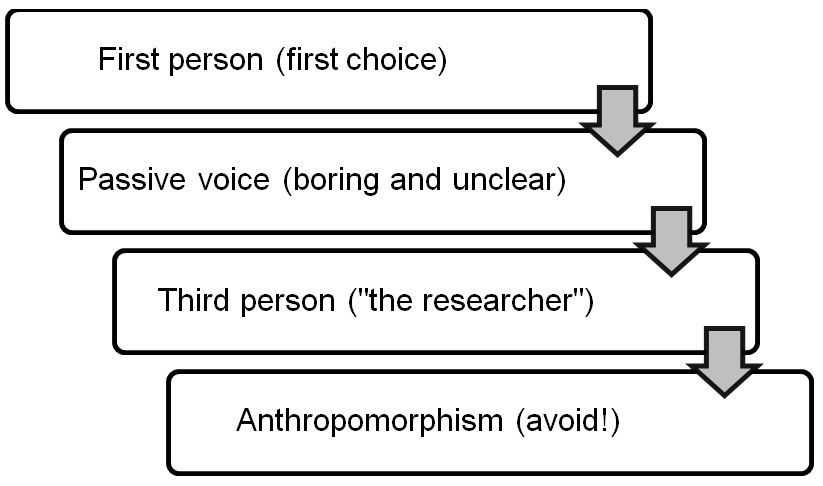Updated for APA 7th edition (2020)
Anthropomorphism (also sometimes called personification) is the attribution of human characteristics or agency to animals or to inanimate sources such as concepts or objects. Writers anthropomorphize a concept or object to avoid using first person and passive voice or simply to liven up their writing. Back in 2010, the authors of the APA style guide cautioned dissertators to avoid anthropomorphism.
Here’s a recap of the APA dissertator’s dilemma:
Passive voice. We know APA writers should avoid using passive voice. (e.g., The teachers were found to be reluctant to change). Passive voice is dull and often unclear.
Active voice. Active voice, in contrast, is lively and clear: The teachers seemed reluctant to change. APA stylists recommend we use first person when we discuss our procedures and findings: I found the teachers reluctant to change.
Third person. However, many institutions, reviewers, chairs, and committees balk at seeing first person in scholarly writing. Thus, we see third person standing in for first person: The researcher found that the teachers seemed reluctant to change.
Anthropomorphism. In addition to third person, we are often tempted to anthropomorphize our study and write something like this: The data suggested that teachers were reluctant to change. What is wrong with this statement, you ask? Well, back in the ancient days of APA 6th edition, we were admonished that data can’t suggest anything. Since when do data have little mouths and brains to offer us suggestions on anything? Data are many things, but they do not have the power to “suggest” anything to anyone. However, researchers can suggest many things, and we often do, based on the data we studied.
In these strange new days of APA 7th edition, you will be ecstatic to hear that data can talk! Yep. Data and other nouns we wanted to embrace but couldn’t—e.g., findings, studies, chapters—have been released from anthropomorphism prison.
Chicago style users have always been able to slide anthropomorphic constructs past their reviewers, but not APA style users—until this brave new world of 2020. Almost all the social science proposals and dissertations I have edited required the use of APA style. However, I don’t think I’ve edited a single document in which the author did not fall at least once into the trap of anthropomorphism. The error is so common in academic writing, I wonder why APA style even bothers to mention it. There’s one right there! APA style is a concept, not a peeved teacher with a clipboard and stopwatch. Argh! Anthropomorphism strikes again!
Anthropomorphism revisited for 2020
At last, no more worries about anthropomorphism! Well, mostly no more worries. See APA 7th edition, section 4.11 for details. We still aren’t allowed to give animals human characteristics, no matter how much it sounds like they actually speak. And some parts of our dissertation are still not allowed to talk. We are still encouraged to use first-person to describe things we do in our research.
Here are some common examples of anthropomorphism, with my assessment of how well the construct complies with APA 7th edition style guidelines:
The study investigated (better to say focused on or addressed; researchers investigate, not studies)
Management encouraged (debatable; I would write managers encouraged)
The paper discusses (better to use addresses)
The theory posits (I would use provides or addresses)
The chapter describes (you might get away with this, I’m not sure I would be so bold, but try it, let me know what happens)
The literature claims (I don’t think so; literature isn’t a monolith. I would write researchers have claimed...)
The data suggested (Yes! We can say this now!)
The findings demonstrate (Yes, this is okay too)
The report talked about (better to use addressed)
The survey collected (maybe, try it and let me know what happens)
And my personal favorite, The theories worked hand in hand (definitely don’t write this)
APA 6th edition explicitly allowed academic writers to use only two verbs with an inanimate object: indicate and show. The strait jacket has been loosened. You may now feel safe to write, “The findings suggest the moon is made of green cheese.”
When I was in my PhD program (way back in 2013), I was told to imagine a box and ask myself, what is a box capable of doing? Can a box do this action (suggest, discuss, demonstrate)? In my book Resubmit!, I offered a list of acceptable, questionable, and unacceptable verbs that could be performed by a box (or by a study, a chapter, a discussion, or the data). Guess it is time for the second edition.
What actions can findings perform? Findings cannot talk but they now can suggest.
When I edit, I feel safe and secure with indicate and show, and I sometimes use provide. I used to feel as if I were pushing the envelope. A chapter doesn’t really provide in the sense that providing something is evidence of agency or will. A chapter is a made up bunch of words on a page, and as such, really can’t provide anything, when you really think about it. But my argument was that a box can provide something: mystery, cookies, fun… so by that logic, a chapter can provide, too. I just wouldn’t rely on a chapter to pay my rent or put food on my table. Now boxes—and chapters, studies, findings, and research—can do all sorts of energetic things. You have more room to wiggle now.
The APA style dilemma
Back in APA 6th edition, we weren’t allowed to use first person AND we were told to avoid passive voice. Now, the best option is to employ some anthropomorphism: for example, the survey collected…, the paper addresses…, the study explored… Yay! See my blogposts on using first person and avoiding passive voice.
For APA 6th edition users, our next best option was to use third person, which means referring to yourself as the researcher. You’ve probably seen this awkward construct before in other researchers’ work and wondered, what the heck? Yep. If our reviewers will not allow us to use first person, that is what we get. Remember, always check with your Chair, Committee members, and other reviewers to make sure they accept first person. You can bolster your case for using first person by referring them to section 2.27 in the seventh edition of the APA publication manual.
For APA users, here is the hierarchy:

Anthropomorphism used to be our last resort. No more! Feel free to write, “This study explored…” Did your study find out something interesting? Go ahead and write, “This study found…” Let your findings suggest at the top of their little lungs! Free at last. Get busy and finish that dissertation!
Sources
American Psychological Association (APA). (2010). Publication manual of the American Psychological Association. Washington, D.C.: Author.
American Psychological Association (APA). (2020). Publication manual of the American Psychological Association. Washington, D.C.: Author.

